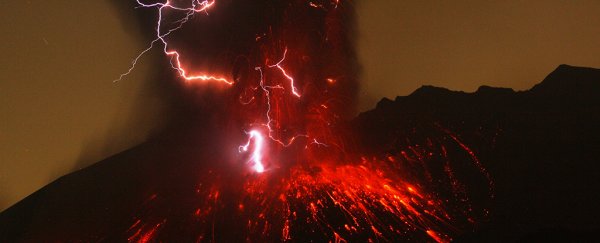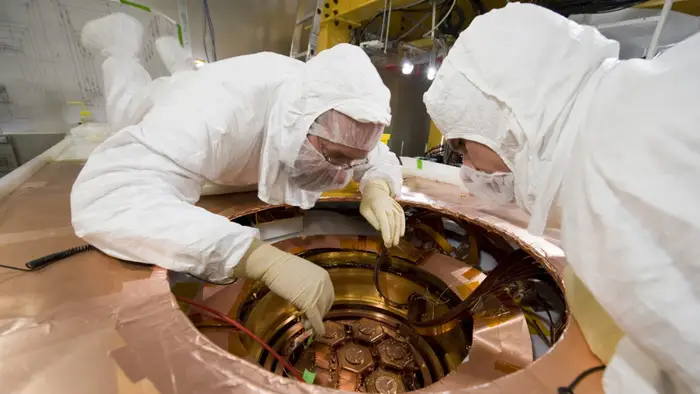
Muons are everywhere. Unbeknownst to you, several hundred strike your head every second.
These subatomic particles – created when cosmic rays enter the Earth's atmosphere – are harmless and quickly decay into clusters of lighter particles.
The particles penetrate objects like X-rays do, which make them useful to scientists, who used muons to uncover a hidden chamber in Egypt's Great Pyramid four years ago.
Scientists also use ghostly muons to map the internal structure of volcanoes, which could one day help predict dangerous eruptions, according to an article published last week in the Proceedings of the Royal Society.
To create those maps, scientists measure how efficiently particles pass through magma flowing through caverns, chambers, and rocky passages in volcanoes, then use that information to create geological blueprints, according to Giovanni Leone, a geophysicist at the University of Atacama in Chile and lead author of the study.
The technique, known as muography, may one day be the "ultimate detection system for magma," Leone told The New York Times, adding that the technique makes it possible to track magma movements that may precede an eruption.
X-raying the inside of a volcano
Muons are like fat, fast electrons: They have a negative charge, but are 207 times heavier than electrons, traveling at nearly the speed of light. That heaviness and speed allows particles to penetrate dense materials like volcanic rock. The denser the object, the more quickly muons lose speed and decay.
Many muons can hit the side of a volcano and travel right through. But if the volcano is dense enough – say, because a passage is filled with magma – a muon won't make it out the volcano's other side.
To spot which muons survived the journey, scientists set up muon detectors on the flanks of a volcano. Those detectors create an image of the volcano's guts by capturing the intrepid muons that didn't decay while passing through the volcano, and noting gaps where muons didn't survive intact.
Some researchers do this mapping from the air by positioning muon detectors inside helicopters and flying near the volcano's flanks.
Think of it like getting your leg X-rayed. During an X-ray, radiation passes through your leg and is captured on camera. If the radiation passes through unobstructed, the image appears black.
But because your leg bones absorb some of the X-rays as they pass through, less radiation makes it to the camera, meaning your bones appear lighter in the image.
In volcanic muography, scientists look for the same contrast: Muons that pass through completely cast dark shadows on the muon detector. But when muons hit dense parts of the volcano and decay more quickly, they leave lighter silhouettes. In short, the denser the object, the lighter the silhouette.
 (Reidar Hahn/Fermilab)Above: Two scientists at the Fermilab in Batavia, Illinois, working on a muon detector.
(Reidar Hahn/Fermilab)Above: Two scientists at the Fermilab in Batavia, Illinois, working on a muon detector.
The more muon detectors surrounding a volcano – some can be almost as large as a tennis court – the better the image.
One detector yields a 2D image, according to David Mahon, a muography researcher at the University of Glasgow, who was not involved with the study.
"By using multiple detectors positioned around the object, it's possible to build up a crude 3D image," he told The New York Times.
Muons could help predict volcanic eruptions
Researchers have used muography to glimpse inside Japan's Sakurajima and Mount Asama volcanoes, as well as three volcanoes in Italy – including Vesuvius – and a Caribbean volcano in Guadeloupe.
Beyond helping scientists map volcanic innards, the new article suggests muography could be used to spot magma reservoirs inside volcanoes that are primed to erupt and to track magma movement in real time.
Eruptions are often preceded by magma rising toward the volcano's summit, and using muons to detect magma flow in that summit area may help scientists detect impending eruptions – allowing people to safely evacuate ahead of an eruption.
"Knowing these issues as early as possible buys critically important time for those responsible for the local alarm and evacuation protocols," the study authors wrote, adding, "forecasting violent volcanic eruptions is the Holy Grail for applied volcanology."
THUMBNAIL Volcanic lightning during an eruption of the Sakurajima volcano. (Mike Lyvers/Moment/Getty Images)
Combining muography with
existing technology to
improve volcanic eruption
predictions

An international team of researchers is proposing that vulcanologists consider using muography with existing technology to improve volcanic eruption predictions. In their paper published in Proceedings of the Royal Society A, the group describes ways they believe muography could be combined with existing technology to provide volcanologists with more information about the status of a given volcano.
Muons are subatomic particles that are created when cosmic rays strike Earth's atmosphere and collide with its atoms. As the muons rain down on the planet, they pass through everything on the surface and below. But because some materials are denser than others, some of the muons can be lost. This has led to the idea of using them to measure the density of objects—to help find a hidden room in the Great Pyramid, for example. Scientists have developed tools that can be used to measure muons, and their use has led to the science of muography. Prior research has shown that muography can be used to study certain geographical features, such as the density of material in a mountain, or a volcano. Prior research has shown that muographical tools can illuminate the makeup of a volcano, which could perhaps lead to eruption forecasts. In this new effort, the researchers suggest that a better approach is to use both muography and existing technology and techniques to learn even more about a given volcano, and hopefully to better predict when it might next erupt.
More specifically, the researchers suggest muography be added to tools such as acoustic and thermal recordings devices that are used to monitor volcanoes that are located near populated areas. Noting certain changes in density of materials inside of a volcano could, over time, come to be seen as a prelude to an eruption.
The authors also acknowledge that there are roadblocks to using muon detecting equipment as part of eruption prediction—most notably, physical hurdles such as when a volcano is surrounded by an ocean or other mountains that shield it from falling muons. They also note that muon detectors are generally far more expensive than other types of sensors. They argue that despite these hurdles, the use of muon detection would be well worth it if it saves lives and reduces property damage.Degassing data suggests Mt. Etna began showing signs of pressure buildup months before 2018 eruption
More information: Giovanni Leone et al, Muography as a new complementary tool in monitoring volcanic hazard: implications for early warning systems, Proceedings of the Royal Society A: Mathematical, Physical and Engineering Sciences (2021). DOI: 10.1098/rspa.2021.0320
Journal information: Proceedings of the Royal Society A
© 2021 Science X Network
No comments:
Post a Comment